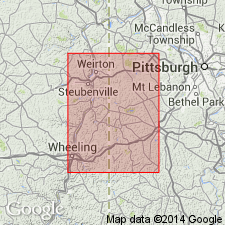
- Usage in publication:
-
- Claysville limestone*
- Modifications:
-
- Original reference
- Dominant lithology:
-
- Limestone
- AAPG geologic province:
-
- Appalachian basin
Summary:
Pg. 78. Claysville limestone. From 205 to 225 feet above base of Greene formation in southern and western parts of Claysville quadrangle is a limestone separated into two layers by 6 to 8 feet of yellow shale. Top layer is 6 to 8 inches thick, bluish-white, and dark-brown on fresh fracture. Bottom layer (in places 18 inches thick) is dark-gray on fresh fracture and weathers with rough surface to reddish or yellow. In northern part of East and West Finley and Morris Townships, the limestone is a rather compact bed, 6 to 8 [inches] thick, the top layers being heaviest and all of dark-gray color. Can not be correlated with any bed previously named and is among most prominent limestones in Greene formation. Is therefore named Claysville limestone, from town in Donegal Township, Washington County, western Pennsylvania. Age is Permian. Adopted by the USGS as Claysville limestone member of Greene formation.
Source: US geologic names lexicon (USGS Bull. 896, p. 455-456); supplemental information from GNU records (USGS DDS-6; Reston GNULEX).
For more information, please contact Nancy Stamm, Geologic Names Committee Secretary.
Asterisk (*) indicates published by U.S. Geological Survey authors.
"No current usage" (†) implies that a name has been abandoned or has fallen into disuse. Former usage and, if known, replacement name given in parentheses ( ).
Slash (/) indicates name conflicts with nomenclatural guidelines (CSN, 1933; ACSN, 1961, 1970; NACSN, 1983, 2005, 2021). May be explained within brackets ([ ]).

